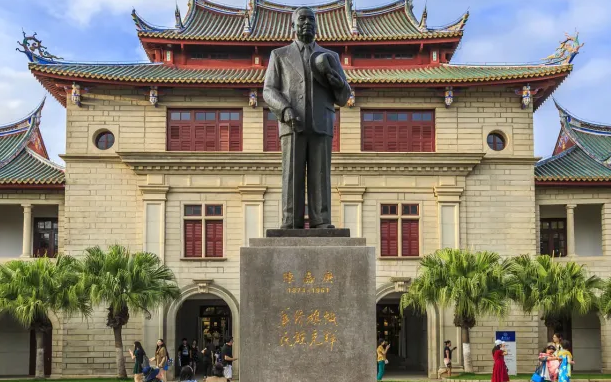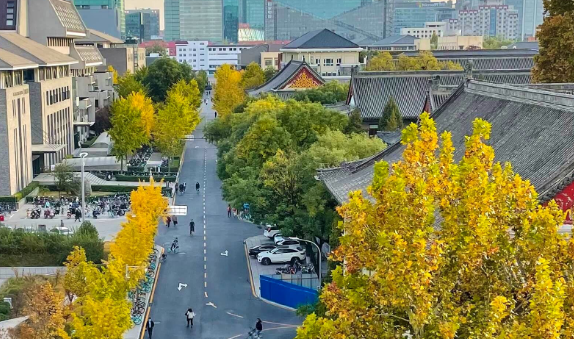China’s universities include comprehensive, technical, normal, agricultural, medical, ethnic minority, and private institutions, with private colleges’ tuition ranging from 20,000 to 60,000 RMB annually.
Table of Contents
Comprehensive Universities
Comprehensive universities, for example, in China, conquer with a wide range of academic disciplines included in their curricula. In addition to sciences and engineering, comprehensive universities entail humanities and social sciences. As a titanic example, we can consider Peking University. Peking University is home to over 30,000 students with a faculty-student ratio of about 1:6, thereby providing close academic contact with teachers and individual attention. Moreover, graduates from comprehensive universities have sufficient skills and knowledge to combine two or more disciplines into a new area of study, such as molecular biology with computer science. Buildings of comprehensive universities take up a vast area of land.
There are numerous state-of-the-art laboratories, vast libraries, where millions of books and journals find their home, students’ cultural and technological centers, which host international symposiums and workshops. The premises of Tsinghua University support more than 100 research institutions within its boundaries. We can also argue that comprehensive universities, such as Fudan University, are a series of forums of the world’s and country’s most urgent problems. In addition, such institutions being academically intense are full of international university community. In the mentioned example, Fudan University takes pride in organizing a culture festival for its students. The festival is attended by representatives of more than 50 countries from the 40s. If future opportunities, regarding the career, are considered, we can state that graduates of the comprehensive Chinese universities have a higher average starting salary compared to other country university graduates. Graduates of such institutions receive an average annual starting salary of about 120,000 RMB.

Technical and Engineering Universities
China’s technical universities and those in the sphere of engineering are important for technical development and specialization in the manufacturing and IT sectors. The institutions thoroughly research the manufacturing economy with programs on aerospace engineering, robotics and material science at Harbin Institute of Technology in China. They also encourage students in heavily hands-on or practical programs that have resulted in actual useful appliances in the country. Beijing Institute of technology offers its students a ph.d. holder who doubles as a dean and who is heavily involved in the students’ projects. Based on Bloomberg’s determination for the ranking of the best universities in China and with emphasis on the investment made in research and growth of university facilities, Zhejiang University has more than 3.5 billion RMB yearly, into the research and development of such technologies as nanotechnology and bioengineering with a number of China’s best professors.
Graduates are offered instant and well-paid jobs when they graduate and are covered in the statistics of employment in the country. Engineering graduates earn starts on a salary of up to 150,000 RMB yearly at Shanghai Jiao Tong University, which surpasses and therefore makes them among the non-technical universities.
Normal Universities (Teachers’ Colleges)
Teachers’ colleges or normal universities are specifically dedicated to preparing educators for their invaluable work in China. These specialized institutions provide thorough training in pedagogy and educational psychology, focusing on teaching methodologies in particular subjects. East China Normal University offers an ideal illustration of this type of institution, as it provides comprehensive programs in education at all academic levels. The distinctive feature of all normal universities is their great emphasis on practical experience in real-life classrooms. For example, ECNU students undertake their coursework in affiliated schools and spend up to 50% of their academic time on practicum placements. Thus, graduates from these universities gain valuable teaching skills and are fully equipped to manage any type of classroom and cater to the educational needs of different types of learners.
In addition to concentrating on traditional educational subjects, normal universities also pay special attention to modern educational technologies. As such, Beijing Normal University makes digital teaching tools an intrinsic part of their programs. Thus, teacher trainees learn how to integrate educational technology in their everyday practice, aiming to master the use of smart boards and educational apps and online platforms. In addition, local and international educational partnerships are also a fundamental characteristic of normal universities.
For example, Shaanxi Normal University is very proud to actively cooperate with UNESCO and implement its highly effective ESD strategy as well as benefit from the latest educational research. In general, these institutions play a key role in China’s educational sector, leading groundbreaking research and reforming education policy and practice. For example, Northeast Normal University has been instrumental in improving education policies for disadvantaged rural areas. Moreover, as a result of the emphasis on teaching practice as well as educational theory, the job prospects are excellent for normal university graduates. Notably, according to migration data, up to 95% of normal university graduates find employment as teachers already within six months of graduating. In addition to a very competitive salary of up to 80,000 RMB per year, normal university graduates have very good career prospects.

Agricultural Universitie
In China, there is a group of the best agricultural universities that work to improve agricultural technologies, food safety, and sustainability. This status quo essay will detail the features, benefits, and world-class facilities that these universities provide. Students engage in practical sessions that include farm management, harvest monitoring, soil monitoring, and animal health checks.
China Agricultural University is the best institution of higher learning focusing on agronomy, veterinary science, and agricultural engineering. Students spend between 4-11 months engaging in practical sessions in CAU’s teaching farms. The universities have top-notch research facilities that can refine genetic, biotechnological, and environmental research. CAU has agencies and departmental collaborative groups that focus on practical research in the fields. There is highly designed infrastructure aimed at sustaining environmental conservancy.
Nanjing Agricultural University invests over 2 billion RMB in research each year. The Group focuses on creating better yield crops and sustainable agronomy. It has created hybrid cereals that are resistant to pests and diseases. The initiative has also created new varieties of maize that are rich in vitamins that are important in nutrition. Additional nutrient-rich varieties include rice, potatoes, and sweeper tomatoes, which helps students benefit from decent job security in the future.
Universities are at the forefront of working alongside global partners. China Southwest University collaborates with the International Rice Research Institute to improve rice production for millions of farmers worldwide. The universities produce ready-to-work graduates in the fields. More than 90% of all graduates have jobs, with most working in government institutions, research firms, non-governmental organizations, and private companies. Graduates earn between 70,000 to 100,00 RMB annually, a decent salary for recent graduates.
Medical Universities
A medical university in China is a type of higher education institution focusing on training healthcare professionals and conducting medical research. The activity of such universities is critical to the advancement of medical science and the enhancement of public health. An example of such a university is Peking Union Medical College offering degrees in medicine, dentistry, nursing, and public health. The training of medical practitioners involves years of study and clinical training in affiliated hospitals. PUMC, for example, has medical students work in teaching hospitals for their final two years, learning about patient care and practices in medicine.
Most universities are well-equipped for medical research, such as Shanghai Medical College of Fudan University. The college spends over 4 billion RMB on research every year, focusing on cancer treatment, cardiovascular diseases, and regenerative medicine. Dennis et al. report on a promising research project that involves the regeneration of living organ tissue using three-dimensional bioprinting. Such projects contribute to medical science development and the discovery of new ways to address diseases.
Universities collaborate and exchange experiences with medical professionals from other countries. For example, Zhejiang University School of Medicine has paired with Harvard Medical School to provide students with the opportunity to learn and conduct research according to the highest standards of medicine worldwide. Dennis et al. mention different exchange opportunities that aid students as well as faculty to keep a global perspective on health matters.
Training in Chinese medical universities leads to the high employability of graduates. Starting salaries are between 120,000 and 200,000 RMB per year, and some schools have up to 100% employment rates. Jobs for graduates are not limited to hospitals, as they can also get hired in private clinics, research institutions, public health organizations, among other places.

Ethnic Minority Universities
Ethnic minority universities are specialized tertiary educational institutions constructed to preserve cultural heritage and develop higher education and culture among ethnic minority. China boasts an extensive history of such universities with Minzu University of China being a central example. The institution offers a variety of educational programs specialized for ethnic minority and preserving their cultural background. Additionally, the secretary of the Communist Party of China emphasized the government plans to expand this model to more regions of the county.
One of the key features of ethnic minority universities is implementing bi-lingual study programs. MUC offers courses in not only Mandarin but in 28 minority languages as well. With 56 ethnicities in China, MUC students engage in a variety of subjects from traditional medicine to modern engineering. The central objective is to link traditional heritage with modern knowledge and resources. At the same time, culture preservation remains a key priority for these universities. Yunnan Minzu University hosts an annual ethnic minority cultural festival, allowing students to demonstrate their traditional dances, music, and crafts. This event helps ethnic minority students develop their sense of identity and pride and introduce their peers and other students to China’s diversity of ethnic minority cultures.
These universities also concentrate on research in areas that affect minority communities directly. Xingjiang Normal University’s research focuses on climate and soil conditions specific for the region and the development of sustainable agriculture. The products of such research and applied projects help locals earn more money and improve the quality of life in ethnic minority regions. Overall, these programs help graduates return to their communities, where they also find an essential role in local development. Employment rate among ethnic minority university graduates is high, especially in the spheres of education and healthcare and local government. They also report high salary rates for beginners, which range from 60,000 to 90,000 RMB per year. These universities also implement targeted support programs that deliver academic and social support to the enrolled students. For example, Tibet University runs a mentorship program where senior students help freshmen to adapt to studying and living at the university.
Private and Independent Colleges
Ethnic minority universities, which are specialized higher educational institutions in China, are aimed not only at educating the students but also of preserving and developing the students’ culture and tradition. As one example, Minzu University of China provides students with an education that is a mixture of traditional Chinese as well as practical skills. Most often, these universities have bilingual programs, where students are taught in both mandarin and their native language. For instance, at Minzu University, where there are students from over 50 ethnic groups, the students can take subjects such as traditional Chinese medicine, ethnic music and dance, as well as modern sciences. This ensures that the students do not lose their language, have a wider range of skills, and use the knowledge to help their communities.
The issue of the culture of the minority in a majoritarian context is one of the most important objectives of these institutions. The Yunnan Minzu University, one of the seven such universities in China, holds an annual gala, which aims at showcasing the talents of the students. The students of each nationality get to display their traditional dance or exhibit their traditional craft. Furthermore, the students themselves participate in the organization of the gala, and the fest gives them an opportunity to display as well as feel pride in their culture. As for the research aspect, it helps develop a society and the solutions of a number of problems.
One of the largest of these is performed by the students and graduates of the Xinjiang Normal University, which is based on the region, whose economy is primarily agrarian. As the result, the university has developed an agricultural method that accommodated the climate, soil composition, and wishes of the local farmers that developed agricultural goods that are no only more sustainable but also of a higher yield. The students of such universities are able to find relatively well-paying jobs in their region. The average starting salary in education and healthcare is around 60,000 RMB a year, while the salary in the government is around 90,000 RMB.
One of the main goals is to educate a certain quantity of students, who will be able to take on responsible jobs in education, healthcare, or the government in order to contribute to the development of their place of residence or to preserve and develop the traditions of their minority. That is why the universities establish student support services that aid the adjustment of the freshmen to their studies and life away from their families. One model of this is the Tibet University, where freshmen get a senior student, who aids them in adjusting to university life and helps them with their studying.
In conclusion, it should be noted that the main goal of ethnic minority universities in China is the preservation of the culture and tradition of the students, alongside with the students’ social adaptation. These students not only get a quality education but each year they have more and more students at their universities.

